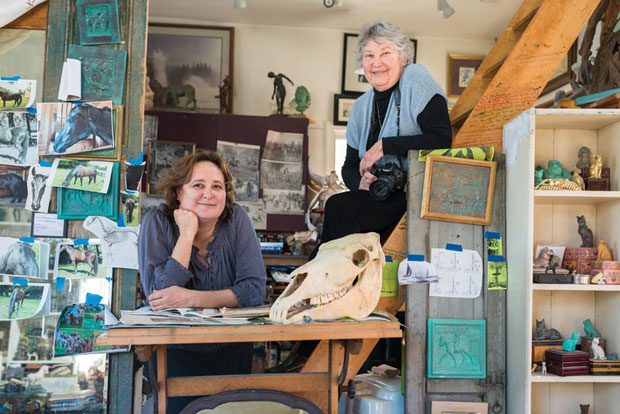
For sculptor Deborah Waddington, Salem County isn’t just a place to live, it’s an inspiration. The same can be said for her mother, Mary Waddington, a photographer, and her late grandmother, Mabel Waddington, a painter.
The Waddington women are descended from Quakers who arrived in Salem by ship more than 300 years ago. These early New Jersey pioneers settled on the lower eastern shore of the Delaware River at what is today Fort Elfsborg in Elsinboro. Deborah and Mary still call Fort Elfsborg home—and still live a simple life that reflects their Quaker faith.
“My biggest inspirations are the river and nature,” says Deborah. “I get energy from being out in nature, away from confusion. I want to be surrounded by beauty. Here, there’s peace and tranquility, but also strength and power from the river.”
Deborah, 55, lives with her husband, Mark Quinette, in a house on the river’s edge, behind a wall often tested by gales and high tides. She and Quinette (a Quaker woman customarily keeps her maiden name after marriage) have two grown children.
Deborah’s studio is located on the ground floor of her home. Here, the morning sun pours in through floor-to-ceiling panes as Deborah sculpts. Her pieces range from small tabletop figures to large public installations. Working on a stool in the center of the studio, she is surrounded by shelves containing rows of the sculptures she has created over the years. Many depict horses in varied poses: bowing, pawing, galloping and strutting. “I specialize in equestrian statues,” she says. “I’ve always wanted a horse, just never got one.”
Her mother, Mary, 76, lives nearby in the house where Deborah was raised. Mary was trained as an oil painter by her own mother, Mabel, who taught art in the basement of her home. “She was a beautiful, creative person,” says Mary. “She set up the easels, and we did our own thing. My mother gave me a long leash.” Mabel died in 1998 at age 88.
Given that long leash, Mary decided early on that “painting is messy.” Putting down her brushes, she “picked up a camera and started taking pictures.” Yet her mother’s teachings stayed with her. “I even used the same measures and rules as painting,” Mary says. “I still had to think about composition and the right lighting and mood and texture. And I loved it.”
The love affair became a vocation more than 40 years ago when the Society of Friends in Harrison Township commissioned Mary to produce a pictorial history of the area’s Quaker families. The project was funded by the National Endowment for the Humanities. Being paid for the work “really turned me on,” she says.
Like her daughter, Mary is inspired by the river, field and forest. “Space, nature and beauty are important to the artist,” she says. “I’ve always been a woolgatherer, a dreamer. Being a Quaker has a tremendous amount to do with these feelings. You can see my respect for nature and the simple life in the photographs I take.”
Mary’s work has appeared in juried exhibitions at the Delaware Art Museum, the National Preservation Conference in San Antonio and the DaVinci Art Alliance Gallery in Philadelphia, among others. During the 1980s, she was the official photographer of the Salem County Historical Society and created multimedia programs exploring Salem County’s rich history. Her work has appeared in magazines published by the Nature Conservancy and Smithsonian Associates, a museum-based educational organization.
“I admire how she looks at and records nature,” says Sheldon Strober, an artist and photographer with studios in Philadelphia and Fort Elfsborg. “Mary can bring out the subtleties of a marsh. She is very soft and quiet. There’s strength in those qualities.”
Lately, for a series of programs commissioned by Philadelphia’s public radio station, Mary has been shooting pictures of Salem County folks who support themselves the old-fashioned way—by farming, crabbing, hunting, fishing and oystering. Alloway resident Mary Schilling produces and co-writes for the series, which starts with a documentary titled Muskratting.
As for Deborah, she recently made a model for a proposed memorial to the scores of fishermen who have died at sea off South Jersey. The memorial—sponsored by the Bayshore Center, the Port Norris Historical Society and the McBride Enterprise, a local preservation group—will be installed at the center at Bivalve in Port Norris on the Maurice River. It aims to “serve as a place of solemn reflection and will commemorate all those who have been lost to the bay over the generations.”
Deborah’s 12-inch clay model depicts a fisherman and his wife standing back to back, holding hands. In their free hands, the man holds a fishnet, the woman a tool for shucking oysters. If chosen by the sponsors, Deborah’s finished sculpture would stand approximately 6-feet tall and take up to two years to complete. The process involves molding ceramic material over a wax figure in six to seven sections. The ceramic mold is fired until the wax runs out, then bronze is poured in the mold to make the final statue.
Deborah has previously honored those who risk their lives. Her bronze statue of a policeman and fireman aiding a child stands in a brick-enclosed archway of the municipal building on Old York Road in Abington, Pennsylvania. A separate bronze sculpture in an alcove above the policeman and fireman depicts three doves in flight, a symbol of peace. “She did a phenomenal job,” says John Livingood, Abington’s deputy chief of police. “Deborah is very talented, and her sculptures have been visited and praised by many.”
When Deborah is not molding miniature horses or life-size fishermen, she puts her talent to work in less permanent way, such as cutting faces on pumpkins for the annual fall Giant Pumpkin Carve that benefits Meals on Wheels of Salem County. “There’s something Zen about carving a pumpkin,” she once told a newspaper reporter.
Charles H. Harrison is a Salem County-based journalist and author.
